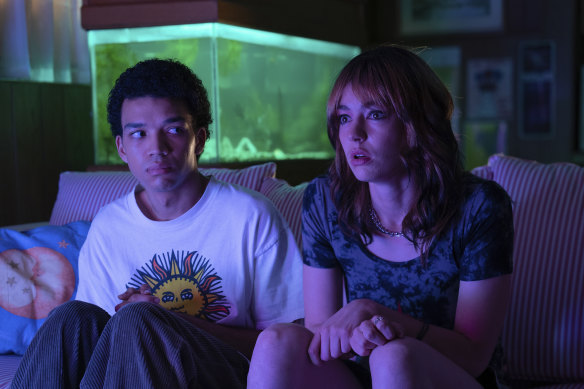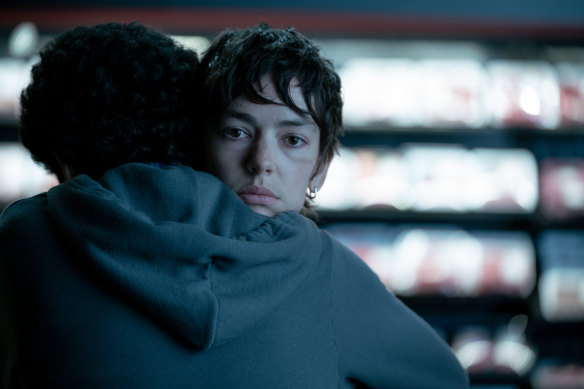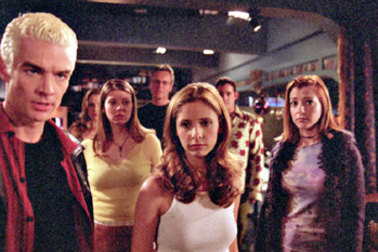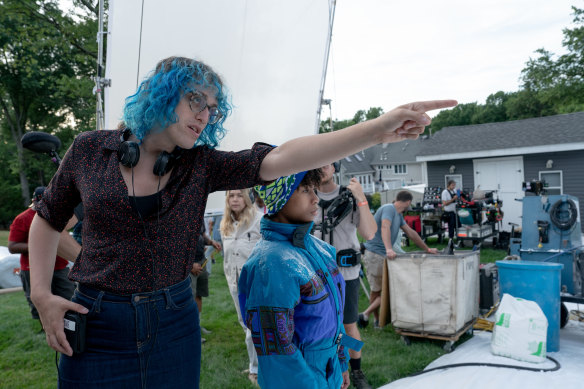Trans director’s inner ‘atom bomb’ inspires a ’90s-style horror fantasy
Jane Schoenbrun’s Buffy-infused I Saw the TV Glow may look nostalgic but it’s anything but warm and fuzzy.
By Karl Quinn

Justice Smith, left, as Owen and Brigette Lundy-Paine as Maddy in I Saw the TV Glow. Credit: AP
For fans of 1990s popular culture, I Saw the TV Glow is a treasure trove. With its vibrant saturated colour palette, it looks like an artefact of the time. Its moody soundtrack evokes the music of the era (despite boasting a plethora of present-day hipster acts such as Caroline Polachek and Phoebe Bridgers’ side project Sloppy Jane).
Much of the plot revolves around a TV show clearly inspired by Buffy the Vampire Slayer and Nickelodeon’s late-night weekend line-up. There are even cameos from Limp Bizkit frontman Fred Durst and Buffy cast member Amber Benson, as well as a nod to the Smashing Pumpkins in the name of its villain, Mr Melancholy.
But none of that makes Jane Schoenbrun’s second feature a piece of warm and fuzzy nostalgia. In fact, it’s anything but.
Though it never states it overtly, I Saw the TV Glow – which in genre terms sits somewhere between horror, fantasy and coming-of-age drama – is about the difficult journey to “unrepression”, says Schoenbrun.
“I wrote the film in the immediate aftermath of coming out [as trans], and dealing with all of the consequences of that decision,” they say.
“I not only had seen it coming, but in many ways those consequences were the very thing that had kept me repressed for so long – this complete atom bomb exploding in my sense of life and reality, eventual estrangement from my family, and in many ways a reassessment of every relationship in my life, not to mention my sense of self and place in the world.”
The prospect of emerging into their authentic self “was exciting, and it was absolutely terrifying”, Schoenbrun says. “And I tried hard to stay with that feeling in the writing of the movie, to not overthink it as metaphor or analogy, but really to make a movie that expressed the complexities of that experience.”
In the film, Owen (Justice Smith) is a lonely, awkward high school teen who finds a soul mate of sorts in Maddy (Brigette Lundy-Paine), a slightly older schoolmate. They bond over a shared love of a TV show called The Pink Opaque (the name comes from a 1985 compilation album by Scottish indie-ambient rockers Cocteau Twins), a show whose storylines, central characters, and blurring of identities seem to speak deeply and in mysterious ways to each of them.

Brigette Lundy-Paine in I Saw the TV Glow.Credit: Spencer Pazer
In other words, the movie tries to capture a sense of alienation from self and the world, and of the solace that might be offered in certain aspects of pop culture that help define and validate a shifting and emergent identity. And for Schoenbrun, Buffy The Vampire Slayer was just such a thing.
The references to the Joss Whedon TV show are intended not simply as fan service, “but as intertextual explorations of that show and what it meant to me and a generation of fans, many of them queer”.

Jane Schoenbrun, photographed at the Sundance Film Festival, where the movie debuted in January.Credit: Monica Schipper
When the young Schoenbrun discovered it as a 10-year-old, “I fell in love, and I fell hard. I really do describe it as my first love, and I mean that quite literally; Buffy became this place where I was putting so many of my emotions that I didn’t feel comfortable exploring in my real life.
“I cared more about the characters on Buffy than I cared about my friends. I cared more about who Buffy went to the prom with than who I went to the prom with. There was some kind of coping mechanism, some kind of dissociation, but also a place to spend all of those feelings that I didn’t feel comfortable exploring in myself for reasons I wouldn’t come to understand until years later. Spoiler alert: they were about being trans, I think.”
Making a film about watching television flies in the face of general wisdom about what makes good cinema, Schoenbrun readily concedes. “Back when I was in film school they told us never film that, it’s uncinematic. But I actually think it’s incredibly cinematic when you’re playing with glow and light. It’s almost like portraiture.”
Screen culture, in one form or another, has been central to Schoenbrun’s work to date. There was the 2018 found-footage documentary A Self-Induced Hallucination, about the Slender Man internet horror phenomenon. And there was the 2021 feature debut We’re All Going to the World’s Fair, which opens with a teenage girl recording a vlog, pricking her finger with a lapel pin in order to draw blood, and invoking a name three times in order to join an occult online game.
“For years I struggled to figure out what my language was, cinematically as an artist,” says Schoenbrun. “And I think I always struggled, especially pre-transition, with this question of, ‘What are my stories to tell?’

James Marsters, Amber Benson, Sarah Michelle Gellar and Alyson Hannigan in Buffy the Vampire Slayer.
“Before I unrepressed, before I came out – which was a very important part of feeling I did have something to say that was authentic – I thought I had something to say that wasn’t mine to say, but that was because I was repressed. But even before that, there was this ‘aha’ moment where I was like, ‘They say write what you know, and what I know about is staring at screens.’ And it really did unlock something, in that I already had complicated feelings about my relationship with media and entertainment.”
The key moment in realising it could be fertile ground for their own artistic practice was the election of Donald Trump in 2016.
“I was understanding the way the internet was quite literally changing our perception of reality, and I was especially fascinated in the Slender Man case with this complicated relationship between fiction and reality, where one was influencing the other, but not in the way we typically think of it, which is that reality happens and then fiction responds. It felt in this case like fiction was helping to create reality.
“I just kept digging deeper and deeper with each project into that idea, and using the screen as this malleable metaphor through which to talk about contemporary identity, to talk about my own identity, to talk about a youth spent living vicariously through fiction rather than my own life, which I think of now as very much a coping mechanism tied to my queerness.”
Schoenbrun has said that I Saw the TV Glow is “a film about the egg crack”, the moment when a person first realises they are trans. But it’s also about what happens to a person when they choose not to heed that revelation.

Jane Schoenbrun on the set of I Saw the TV Glow.Credit: Spencer Pazer
Owen’s journey in Glow is unnerving, horrific, and far from complete. And, Schoenbrun says, there may be more to come.
“I definitely, actively want to make another film in this world,” they say, hinting that it could be a sequel, but not necessarily in the way we generally envisage such a thing.
“Some work you finish and you know you shouldn’t see where those people go next. But with this film there’s definitely a different perspective, from a different side of everything, that I would be interested in peeking back in at.”
Will there be screens in it?
“I’m obsessed with the moving image,” says Schoenbrun. “I think you can express so much emotion and so much of the ephemerality of cinema in just a gaze on an unseen screen. On a purely cinematic level, it’s something I can film over and over again without getting tired of it.”
I Saw the TV Glow is in cinemas from August 29.